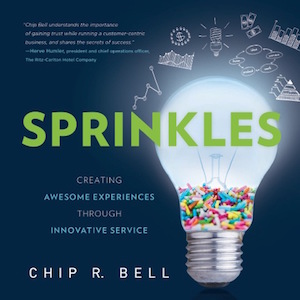How to Create a Culture of Exceptional Customer Service

Chip Bell advises companies like General Electric, The Ritz-Carlton, and Hertz on how to prosper by exceeding their customers’ already high expectations. As an expert consultant for more than 35 years, he’s seen it all when it comes to excellent — and not-so-excellent — customer service. And he’s on a mission to help companies deliver truly delightful service.

Chip has unlocked the keys to this kind of service in numerous books, including the recent Sprinkles: Creating Awesome Experiences through Innovative Service.
The common theme? Memorable, delightful, game-changing service that makes customers want to stick with your company isn’t about how much money you spend.
“It’s based on whether you make their life easier, whether you make their life meaningful and joyful, and whether the experiences you provide make them advocate for you and tell people about you,” Chip says. “These relationships have become a much bigger portion of the value path than they have ever been before.”
Download a sample chapter from Sprinkles >>
It begins with the leadership
Building that culture of service starts at the top, Chip says. Service-oriented companies that are known for excellent or memorable customer service, such as Nordstrom, Southwest Airlines, and Zappos, may even have CEOs who are constantly interacting with customers in the field.
 Chip recalls checking into a Marriott Hotel in Miami and seeing then-CEO Bill Marriott working the reception desk — something he does at more than 100 properties a year.
Chip recalls checking into a Marriott Hotel in Miami and seeing then-CEO Bill Marriott working the reception desk — something he does at more than 100 properties a year.
When executives interact with customers, whether in person or by staffing a call center, they serve as role models to their employees while gaining firsthand knowledge of customers’ opinions.
“In winning organizations, all of the leaders embrace the focus on customer service,” says Chip. “Is one person in charge of the bottom line? The obvious answer is no. Everyone in the organization should be concerned with the bottom line. And it’s the same with the culture of service. If we want to be known for being distinctive in the world of service, it needs to be embedded in the value system of everyone in the organization.”
In addition, leaders of successful organizations rely on customer data to make strategic decisions. It no longer works to run plans by the quarterly focus group. These companies channel in-the-moment data from customers regarding new products, new locations, or service changes.
“When you find a smart, successful organization, they can tell you what the customer thought the day before yesterday,” notes Chip. “They are gathering data the right way and making it part of the dashboard by which they run their organizations.”
Anyone can contribute to exceptional customer service
Creating a culture of service also means engaging even those employees who never interact with customers, such as IT or human resources staff. Executives can empower them to focus on serving the people who serve customers to help them do a better job, says Chip.
“The number-one impact on customer relations is employee relations,” he says. “How we serve each other gets echoed to the external customer.”
In other words, the same practices that make customer-facing employees feel delighted and supported are likely to contribute to making the customers feel the same way.
“Any company can do this. It’s a matter of making it important and something you do every day,” Chip says. “It’s doing things that touch people’s hearts and say, ‘This is an organization that cares about me.’ It is keeping the simplicity and the human connection in all that we do.”
The Importance of Value-Unique Service
Excerpted with permission from Sprinkles: Creating Awesome Experiences Through Innovative Service by Chip R. Bell (Austin: Greenleaf Book Group, 2015).
Leaders of organizations have spent years focusing on delivering value-added service. Yet today’s customers, with their inclination toward elevating their expectations every time a service provider adds more, have almost run the delivery of service delight straight into the too-pricey zone. Each time a service provider adds more in their effort to exceed customer expectations, it comes closer to completely eliminating profit margins already razor thin for most.
The new perspective reflected in both this book is this: value-unique service and not value-added service provides a more promising path to delight—one with ingenuity, not addition. We all have unlimited ways to serve uniquely but only a finite number of ways to add more. My hope is the gourmet cooking metaphor [used throughout the book] will unleash fresh ideas and tasty techniques for delivering innovative service: good, but also pleasurable enough for customers to remark about it to others.
Bottom line — this book is about your bottom line. Customers today crave special and unique. They are not only tired of ho-hum, they are bored with the “pretty-good-but-nothing-to-write-home-about” kind of service. When a large brokerage firm decided to have fun with their phone tree by adding “punch 8 to hear a duck quack,” they were stunned when over a million people a week called just to hear the duck. The punch line? Customers want service à la mode. They gravitate toward people with spirit, organizations with imagination, and leaders with spunk. They want their service experiences delivered with sprinkles.
At Redbooth, we’re committed to helping teams and companies across the globe to work smarter, collaborate better, and maximize productivity. Sign up for free (no credit card required) to get Redbooth’s collaboration software >>